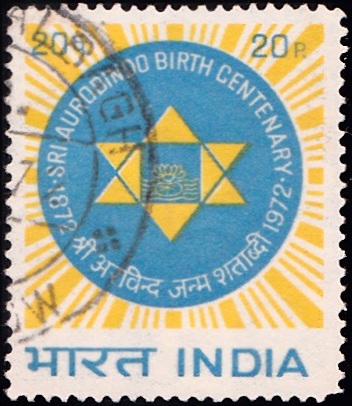
Sri Aurobindo 1972
A commemorative postage stamp on the Birth Centenary of Aurobindo Ghose, an Indian Bengali philosopher, yogi, guru, poet and nationalist :
Issued on Aug 15, 1972
Issued for : The Posts and Telegraphs Department are privileged to bring out a special stamp commemorating the birth centenary of this honoured son of India.
Description of Design : The design of the stamp is vertical and depicts the symbol of Sri Aurobindo. The sun around the symbol represents the supermind.
Designed by : The stamp was designed by Shri Jayantilal Parekh of the Pondicherry Ashram.
Type : Stamp, Postal Used
Colour : Golden Yellow and Oriental Blue
Denomination : 20 Paise
Overall Size : 3.34 X 2.88 cms.
Printing Size : 2.987 X 2.524 cms.
Perforation : 13½ x 14
Watermark : Printed on unwatermarked adhesive stamp paper
Number Printed : 30,00,000
Number per issue sheet : 42
Printing Process : Photogravure
Designed and Printed at : India Security Press
Name : Aurobindo Ghose
Born on Aug 15, 1872 at Calcutta, Bengal Presidency, British India
Died on Dec 5, 1950 at Pondicherry, French India [now in Puducherry]
About :
- 15th of August, 1972 commemorates not only the Silver Jubilee of the achievement of Independence by India but also the birth centenary of one of her illustrious sons, namely, Sri Aurobindo who was, at one stage, in his career, actively associated with the freedom struggle in India.
- The latter half of the 19th century saw the birth in India of several personalities who attained high eminence in diverse fields. Of these, the name of Sri Aurobindo stands among the foremost. After receiving his early education in India, he studied for 14 years in England. His career in England was marked with several successes. Sri Aurobindo mastered several European languages including Greek and Latin, passing the Classical Tripos from the University of Cambridge with First Class Honours and winning all the prizes in the Classics. As a student at Cambridge, Sri Aurobindo participated in the debates of the Indian Majlis making revolutionary speeches where one could discern several hints about achieving independence through armed revolution. Later in 1890, he passed the open competition for the Indian Civil Service, but he felt no urge to join that service and managed to find some way to escape from that bondage.
- Sri Aurobindo returned to India in 1893 having secured an appointment in the State of Baroda where he spent 13 years. During this spell at Baroda, Sri Aurobindo learnt several Indian languages including Sanskrit and made a deep study of the literature, scriptures and the cultural heritage of India. He also frequently contributed to ‘Indu Prakash‘, a Marathi-English Journal of Bombay. In his writings which were fired with revolutionary zeal, he criticised his contemporaries in the political field and was not afraid to put forth his own challenging and radical ideas on the subject of achieving independence for the country.
- The Partition of Bengal in 1905 threw him into the thick of politics. He relinquished his post at Baroda and accepted the appointment of Principal of the newly established National College at Jadavpur. At about this time, he started the ‘Yugantar‘, a Bengali daily and was also associated with the “Bande Mataram“, the English daily of Bipin Chandra Pal. Through these newspapers, he gave expression to his ideas of patriotism, love of freedom and sacrifice in the cause of motherland. It was not before long that alien Government started taking notice of these activities.
- Early in May, 19018, Sri Aurobindo was arrested along with 38 other revolutionaries in the Alipore Bomb Case and remained an under-trial prisoner for a year. This period however proved to be the turning point of his life. Fate had cut out Sri Aurobindo for a very different type of leadership. Even as a young boy, Sri Aurobindo had a spiritual bent of mind. When Sri Aurobindo came out of the prison in 1909, politics no longer could claim his undivided attention. In fact, very soon with the inner assurance that the liberation of India was inevitable, Sri Aurobindo retired from active politics withdrawing to Pondicherry in French India where he exclusively concentrated on spiritual work which he now considered to be of primary importance for all humanity.
- After a few years of Yoga between 1914 and 1920, Sri Aurobindo started contributing articles for the philosophical monthly the ‘Arya‘ in which were published almost all his major works. The Ashram which he founded at Pondicherry was not a planned institution in the beginning, but it grew as disciples flocked to him from all parts of the world to learn Yoga. On 29th March, 1914, a French lady, reverently known as the ‘Mother’ arrived in Pondicherry and joined him in his work in the Ashram. Sri Aurobindo later on entrusted the development of the Ashram to the ‘Mother‘.
- The sequence of Sri Aurobindo‘s thoughts, his ideas and ideals and his approach to spiritualism are mirrored in his works, more famous among which are: The Life Divine, The Synthesis of Yoga, Essays on the Gita, The Human Cycle, The Foundations of Indian Culture and The Future Poetry. His magnum opus is the epic, ‘Savitri‘.
- The Ashram founded by Sri Aurobindo in Pondicherry is now an international centre of over a thousand people. The Sri Aurobindo Society, World Union and the Sri Aurobindo International Centre of Education are some of the institutions inspired by him and which propagate his message. The demise of Sri Aurobindo took place on the 5th December, 1950, but the work he initiated continues under the guidance of the Mother.



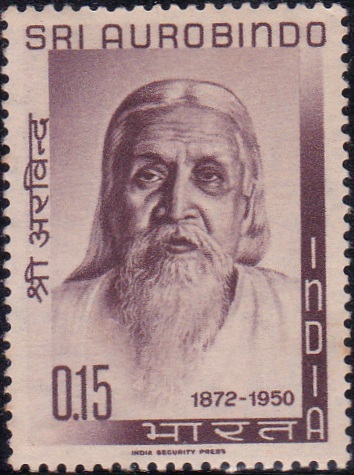
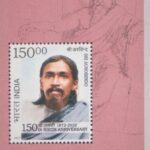

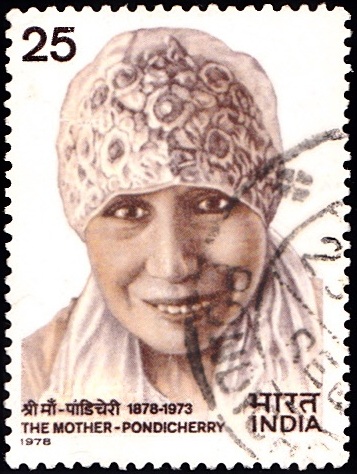
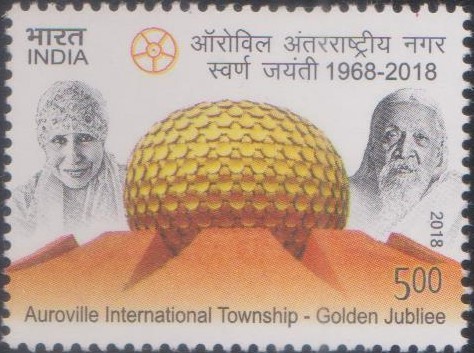
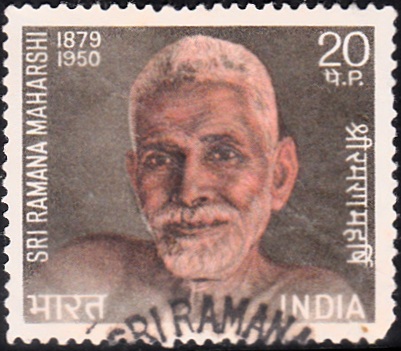
[…] she came into spiritual contact with several teachers and had an internal first vision of Sri Aurobindo in 1904, ten years before she actually saw him physically at Pondicherry in […]
[…] Aurobinda Ashram, Delhi. “All life is Yoga“ – is the revolutionary doctrine of Sri Aurobindo. As a true follower of this doctrine, he worked tirelessly towards making the Delhi Centre what it […]
[…] earlier in 1875. Writing in the English Daily, ‘Bande Mataram‘, on 16th April, 1907, Sri Aurobindo said: “It was 32 years ago that Bankim wrote his great […]